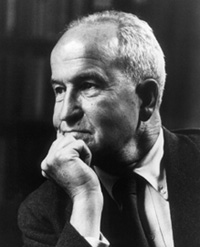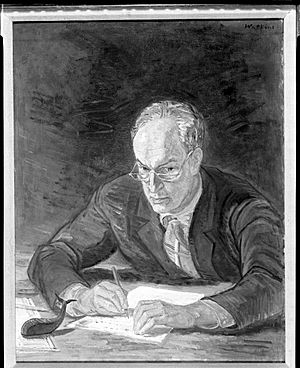Henry Murray facts for kids
Quick facts for kids
Henry Murray
|
|
|---|---|
 |
|
| Born | May 13, 1893 New York City, New York, U.S.
|
| Died | June 23, 1988 (aged 95) Cambridge, Massachusetts, U.S.
|
| Alma mater | Harvard University (AB) Columbia University (MD, MA) University of Cambridge (PhD) |
| Known for | Personality psychology Thematic Apperception Test |
| Awards | Bruno Klopfer Award (1967) |
| Scientific career | |
| Fields | Psychology |
| Institutions | Harvard University |
| Influences | Carl Jung |
| Influenced | Abraham Maslow, Ted Kaczynski |
| Signature | |
Henry Alexander Murray (born May 13, 1893 – died June 23, 1988) was an American psychologist who worked at Harvard University. He is famous for his ideas about personality. He also helped create a well-known psychology test called the Thematic Apperception Test (TAT).
From 1959 to 1962, Murray led some experiments at Harvard. These studies caused stress and upset to the students involved. One of these students was Ted Kaczynski, who later became known for committing serious crimes.
Contents
Early Life and Education
Henry Murray was born in New York City into a wealthy family. He had an older sister and a younger brother. Some experts believe that his difficult relationship with his mother made him very aware of people's "needs." This idea later became important in his work.
Murray went to Harvard University for his first degree. There, he played football, rowing, and boxing. He later studied medicine at Columbia University, earning his M.D. and an M.A. in biology in 1919. He then taught physiology at Harvard for two years.
In 1928, when he was 35, he earned his doctorate in biochemistry from the University of Cambridge in England. A key moment in his life was meeting the famous psychologist Carl Jung in Switzerland. This meeting made Murray seriously consider a career in psychology.
Professional Career and Key Ideas
In 1927, Murray became an assistant director at the Harvard Psychological Clinic. He developed several important ideas about personality.
Understanding Personality: Needs and Press
Murray created a theory of personality called personology. This theory focuses on two main ideas:
- Needs: These are inner forces that drive our behavior. Murray talked about "latent needs" (which are not openly shown) and "manifest needs" (which are seen in our actions).
- Press: These are outside influences or events that affect our motivation.
He also developed the idea of "thema." This is a pattern of how our needs and outside influences come together in specific situations.
The Thematic Apperception Test (TAT)
In 1935, Murray worked with Christiana Morgan to create the Thematic Apperception Test (TAT). This test helps psychologists understand a person's thoughts and feelings. People are shown pictures and asked to tell a story about what is happening in each picture. The idea is that people will project their own thoughts and feelings onto the pictures. Murray called the TAT "the second best-seller that Harvard ever published."
In 1937, Murray became the director of the Harvard Psychological Clinic. In 1938, he published his famous book, Explorations in Personality. This book included a description of the TAT.
Work During World War II
During World War II, Murray worked for the Office of Strategic Services (OSS). This was a US intelligence agency. He helped create ways to select secret agents. These methods involved "situation tests," where people were assessed through practical tasks.
In 1943, Murray helped write a report called Analysis of the Personality of Adolph Hitler. This study used many sources to create a profile of Hitler. It was an early example of "offender profiling" and political psychology.
Harvard Experiments (1959–1962)
After the war, Murray returned to Harvard. From 1959 to 1962, he conducted experiments on 22 Harvard students. These studies aimed to see how people reacted to extreme stress. The students were not fully aware of the nature of the experiments. They were exposed to harsh verbal attacks designed to cause high levels of stress and upset. They then watched recordings of their own reactions.
One of the students involved was 17-year-old Ted Kaczynski. He later became known as the 'Unabomber,' a person who committed serious crimes. Some people believe that Kaczynski's experiences in these experiments affected his later actions. Some sources have also suggested that these experiments might have been connected to the US Government's MKUltra project, which researched mind control.
Later Life and Legacy
In 1962, Murray became a professor emeritus, meaning he retired but kept his title. He received several awards for his contributions to psychology.
Henry Murray passed away from pneumonia at the age of 95.
Murray was also an expert on the American author Herman Melville. He collected many books and items related to Melville, which he later gave to the Berkshire Athenaeum library.
Understanding Personology
Murray's theory of personality, called personology, is explained in his 1938 book, Explorations in Personality. Personology is a way of studying the whole person at once. It looks at how different parts of a person's life and environment affect their personality.
Murray believed that a person's personality changes and grows over time. It is shaped by all the events in their life. He thought that to truly understand someone, you need to look at their entire life story.
Murray's personology has five main ideas:
- Brain's Role: Our brain controls all parts of our personality.
- Tension and Satisfaction: People act to reduce stress and feel satisfied. But they also like excitement and activity, not just being completely calm.
- Lifelong Development: Personality keeps developing throughout a person's life.
- Change and Progress: Personality is not fixed; it can change and improve.
- Unique and Shared Traits: Everyone has some unique qualities, but also some qualities that are common to all people.
Murray's ideas were influenced by psychoanalysis, which looks at unconscious thoughts and feelings. He used methods like free association (saying whatever comes to mind) and dream analysis to understand a person's inner world. His work has influenced other psychologists, like David McClelland.
Selected Works
Books
- Explorations in Personality, with a foreword by Dan P. McAdams. New York: Oxford University Press (1938); reissue (2008).
- Assessment of Men: Selection of Personnel for the Office of Strategic Service, with OSS Selection Staff. New York: Rinehart (1948).
- Personality in Nature, Society, and Culture, with Clyde Kluckhohn. New York: Knopf (1953).
- Myth and Mythmaking. New York: G. Braziller (1960).
Articles
- "The Effect of Fear Upon Estimates of the Maliciousness of other Personalities." Journal of Social Psychology, vol. 4, no. 3 (1933), pp. 310-329. .
- "Psychology and the University." Archives of Neurology and Psychiatry, vol. 34 (Oct. 1935). .
- "Assessment of OSS Personnel," with Donald W. MacKinnon. Journal of Consulting Psychology, vol. 10, no. 2 (1946), pp. 76-80. .
- "America's Mission." Survey Graphic, vol. 37, no. 10 (Oct. 1948), pp. 411-415. Full issue. Full audio.
- "In Nomine Diaboli." New England Quarterly, vol. 24, no. 4 (Dec. 1951), pp. 435-452. . JSTOR 361337.
- "Introduction to the Issue 'Myth and Mythmaking.'" Daedalus, vol. 88, no. 2, Special Issue: Myth and Mythmaking (Spring 1959), pp. 211-222. JSTOR 20026491.
- "The Personality and Career of Satan." Journal of Social Issues, vol. 18, no. 4 (Oct. 1962), pp. 36-54. .
- "Studies of Stressful Interpersonal Disputations." American Psychologist, vol. 18, no. 1 (1963), pp. 28–36. .
Reviews
- "This is 'Psychology'..." Review of Personality: A Biosocial Approach to Origins and Structure, by Gardner Murphy. Survey Graphic, vol. 37, no. 3 (Mar. 1948), pp. 167-168.
- Review of Anthropology and the Classics, by Clyde Kluckhohn. American Anthropologist, vol. 65, no. 1 (Feb. 1963), pp. 139-140. .
- "The Freudian Hawthorne." Review of The Sins of the Fathers: Hawthorne's Psychological Themes, by Frederick C. Crews. The American Scholar, vol. 36, no. 2 (Spring 1967), pp. 308–312. JSTOR 41209472.
Contributions
- "The Effect of Fear upon Estimates of the Maliciousness of Other Personalities in Understanding Human Motivation." In: Understanding Human Motivation, by C. L. Stacey & M. DeMartino (eds). Cleveland: Howard Allen Publishers (1958). pp. 327–342. . Abstract.
- "Historical Trends in Personality Research" (Part One: Overview). In: Perspectives in Personality Research, edited by Henry P. David and Johannes C. Brengelmann. Berlin: Springer Science+Business Media, LLC (1960). pp. 3-39. ISBN: 978-3662395981.
- Introduction to Myth and Mythmaking, by Henry A. Murray (ed). New York: G. Braziller (1960). pp. 9-17.
- "The Possible Nature of a 'Mythology' to Come" (Chapter 17). In: Myth and Mythmaking, by Henry A. Murray (ed). New York: G. Braziller (1960). pp. 300-353.
Reports
- Analysis of the Personality of Adolph Hitler: With Predictions of his Future Behavior and Suggestions for Dealing with Him Now and After Germany's Surrender. Washington: Office of Strategic Services (1943). Full text.
See also
 In Spanish: Henry Murray para niños
In Spanish: Henry Murray para niños


